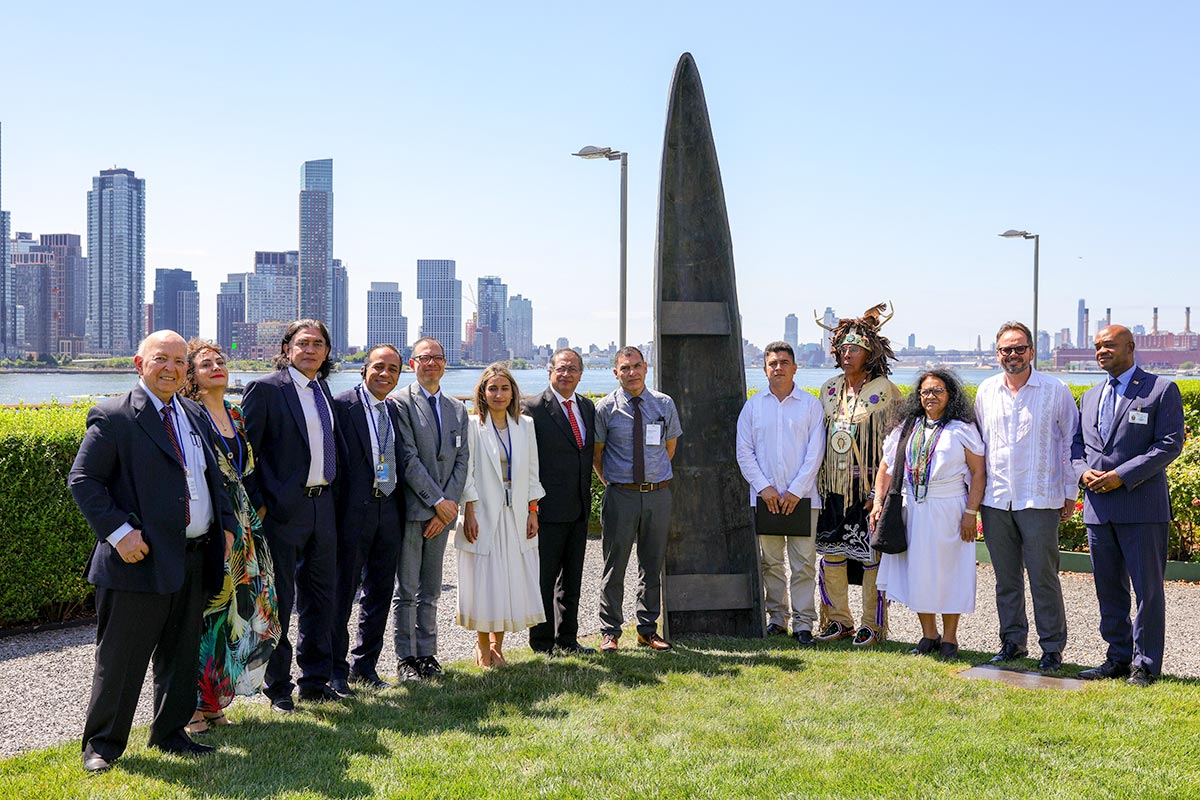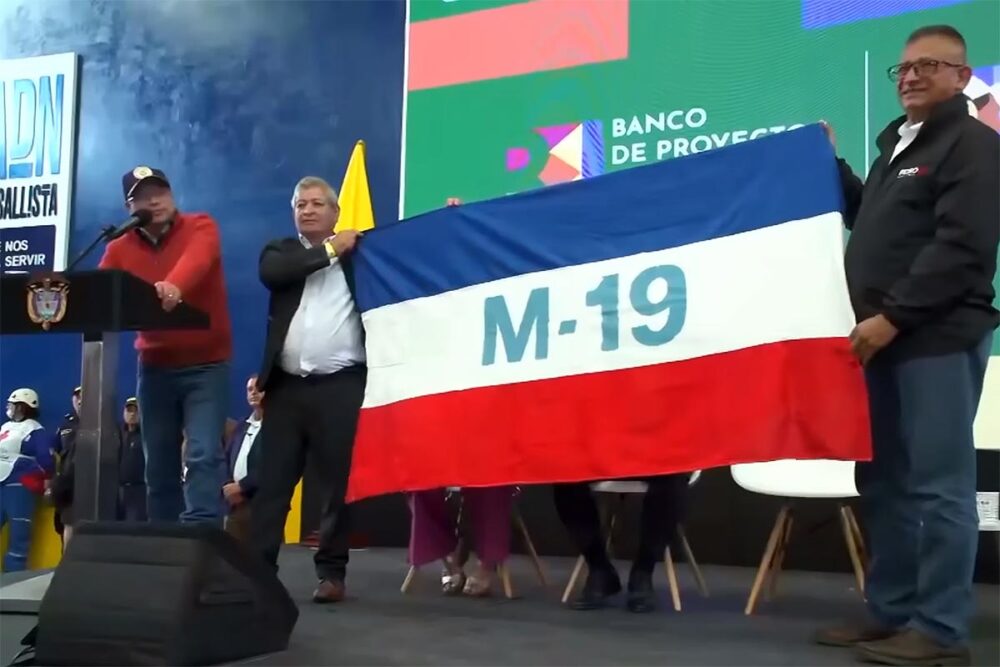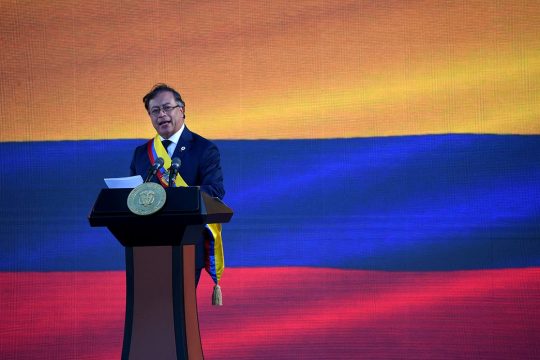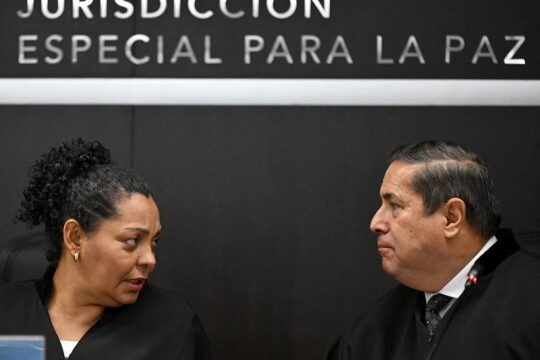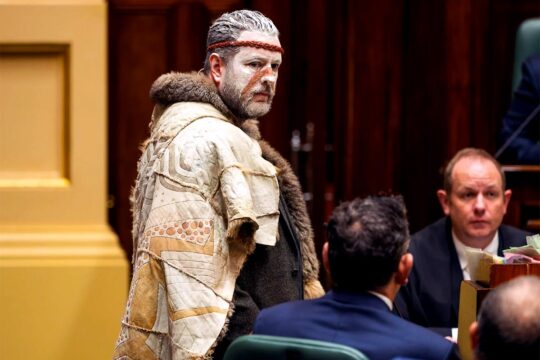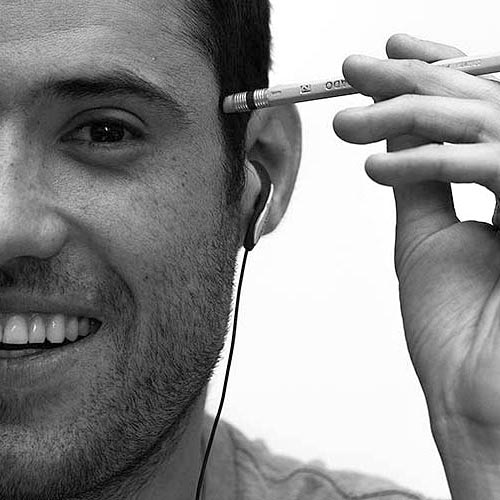On April 26, while speaking at the school he graduated from five decades ago in the city of Zipaquirá, Colombian President Gustavo Petro asked to wave a blue, white and red flag on stage. “They don’t like it when we display it, right?” he said, laughing. “But we’re not keeping it under the mattress.”
In the centre of the flag lied the emblem ‘M-19’. A letter and two numbers that spell out the acronym of the April 19th Movement guerrilla, one which Petro was part of for twelve years, until it signed a peace deal with the Virgilio Barco administration, laid down its weapons in March 1990 and morphed into a political party, under its new name M-19 Democratic Alliance. In May 1990, its presidential candidate Antonio Navarro obtained 12%, an unprecedented score in a country until then strongly bipartisan and despite the fact that their original candidate, Carlos Pizarro, had just been assassinated. Within six months, the new party had won a quarter of the seats in the historic 1991 Constituent Assembly that replaced Colombia’s 19th century Constitution.
But the flag Petro celebrated in Zipaquirá didn’t feature the wavy lines of the M-19 Democratic Alliance that helped modernize the country and for which he served in Congress for three years, but the horizontal stripes of the rebel group who took up arms against the state.
As Colombia’s first leftist president displays and publicly celebrates several symbols linked to the defunct guerrilla, this is perceived by many Colombians as a glorification of the armed struggle, at a time when the president is unsuccessfully trying to negotiate peace with several illegal armed groups, and the country awaits the first transitional justice rulings on war crimes and crimes against humanity committed by the army and by members of another demobilized guerrilla group, the FARC.
“President Petro knows that the M-19 flag does not say anything respectable to the majority of Colombians; on the contrary, it represents reprehensible, even repugnant, events and stories. To use it in his capacity as president of all Colombians is insolent and above all stupid,” said former congressman Iván Marulanda.
“We won’t hide this flag”
From the day he came to power in August 2022, Petro has extolled several symbols linked to the guerrilla, in which he fought under the nom de guerre “Aureliano”, like the lead character in Gabriel García Márquez’ book, One Hundred Years of Solitude.
His first order upon taking office was to send for liberator Simón Bolívar’s sword, which half a century before the M-19 stole from a museum, in its foundational performance. In January 2024, the Ministry of Cultures commemorated the 50th anniversary of the sword’s “recovery”, adopting the M-19 narrative of the event and organizing a conversation with two former members of the guerrilla group. Then, on April 19, Petro decreed a civic day to save water - coinciding with the date of the M-19’s founding milestone and his own birthday. A month ago, when Mexico elected Claudia Sheinbaum as its first female president, his congratulation message emphasised that she’d “helped the M-19 in Mexico in its underground years”.
At the same time, Petro has surrounded himself in government with many former comrades in arms and party. Otty Patiño is his peace commissioner responsible for the eight ongoing negotiations, while former congresswoman Vera Grabe heads talks with the National Liberation Army (ELN) guerrilla. Gloria Quiceno is a negotiator with the Central General Staff (EMC), the largest FARC dissidence to walk away from the 2016 peace deal. Carlos Ramón González heads the intelligence agency, after having been his chief of staff, and his top confidant, Augusto Rodríguez, heads the Protection Unit.
But his most recurring icon has been the rebel group’s flag, which Petro vehemently defends. “No, gentlemen of the oligarchy, we shall not hide this flag, we will continue raising it,” he exclaimed during the May 1st march. “It’s become fashionable that, 34 years later, we cannot use the symbols of the force that became a majority by popular vote in the Constituent Assembly and birthed the current Constitution: the M19,” he said in June, mixing political party and guerrilla, as if they were the same.
Petro’s ambivalences on M-19 and armed struggle
But despite Petro’s lack of distinction, the “Eme”", as M-19 is colloquially called, has had two realities. One of an urban and charismatic guerrilla, -very different from the more rural ones that have predominated in Colombia-, known for its audacious coups questioning the historical and undemocratic distribution of power between two parties in Colombia. And one of painful episodes such as the 1976 kidnapping and murder of union leader José Raquel Mercado, which made it - according to the TRC - “the first guerrilla that openly used people’s freedom as an instrument to achieve political ends”.
Its most notorious and tragic act was the siege of the Palace of Justice in Bogotá’s central square in November 1985, in a still confusing episode that ended with a violent retaking by the army and the burning down of the judicial branch’s building. A hundred people died, including most of the Supreme Court and State Council justices. Six military officers have been convicted for this incident described by the TRC as “a political suicide for the M-19, although this rebel group only admitted it as a military mistake”. At that time, Petro was in prison, where he served an 18-month sentence for carrying illegal arms.
This ambivalence is also seen in the president’s position on the armed struggle. “If we hadn’t done it [taking up arms], would Colombia be more or less democratic? The answer I give myself is that it was necessary,” he said in an interview before his election in which he defended his role in M-19 as political, adding that pacifist leaders like Nelson Mandela had also fought in guerrillas. “We had the right to rebel.”
After laying down their arms in 1990, members of M-19 benefited from broad pardons, didn’t face transitional justice and, save for exceptional cases, didn’t have to provide the truth, listen to their victims nor ask for forgiveness. On the contrary, after the Rome Statute, other armed groups such as FARC or the paramilitaries, had to go before transitional mechanisms such as the Special Jurisdiction for Peace (JEP), where they were confronted by their victims and had to seek forgiveness. Many such leaders, like former FARC top commander Rodrigo Londoño, say that armed struggle is “outdated”.
Pizarro’s hat and Torres’ cassock
The president's ambivalence regarding armed struggle is best seen is in Petro’s decision last month to commemorate the discovery of belongings of two deceased former guerrilla leaders.
In mid-June, Petro announced from Sweden that he’d received the straw hat worn by Carlos Pizarro when he was shot in a flight to Barranquilla in April 1990, in the middle of his electoral tour as the M-19 Democratic Alliance’s first presidential candidate. He then ordered it to be recognized as national cultural heritage, ignoring the procedures to do so. Eight days later, Petro announced that a cassock he’d received weeks earlier was the one worn six decades ago by the priest Camilo Torres before leaving the Catholic Church to joint the recently created National Liberation Army (ELN) guerrilla. “May he live on in Colombians’ memory,” he said.
Both Pizarro and Torres were charismatic characters who have aroused fascination, but whose lives ended up symbolizing opposite reflections on the armed struggle. Pizarro, the top M-19 commander who led the group's move from weapons to votes, became one of the tragic icons of the bloodiest electoral campaign in Colombian history in which three candidates were assassinated and of the nefarious custom of assassinating those who wager on peace.
In contrast, Torres, the ‘rebel priest’ who went from defending liberation theology to taking up arms, died in his first combat against the army in 1966. In the TRC’s words, “he went from rejecting violence to taking up arms, given the persecution, stigmatization and risk he experienced”, in a “process of radicalization [that] inspired many”. To this day, he is one of the major symbols of the ELN, a guerrilla group that not only remains in arms but has shown little willingness for peace with past governments. With Petro’s own administration, they have made little progress amid mutual recriminations and the ELN’s decision in May to resume kidnapping for economic purposes. According to the TRC, the group is responsible for 17,735 homicides and 9,538 kidnappings.
Even if there is a strong argument that Pizarro was a man of peace, the protection of his hat caused controversy. Perhaps less for the object and more for the political context, given that his daughter María José, a congresswoman from Petro’s party, is touted as a possible presidential candidate for 2026 and that Petro has been proposing a new constituent assembly to replace the Constitution whose authorship he has precisely claimed. “What’s really an important and poignant symbol of peace with the M-19 is the 1991 Constitution. That’s the cultural heritage we must protected and defend,” wrote novelist and essayist Juan Esteban Constaín.
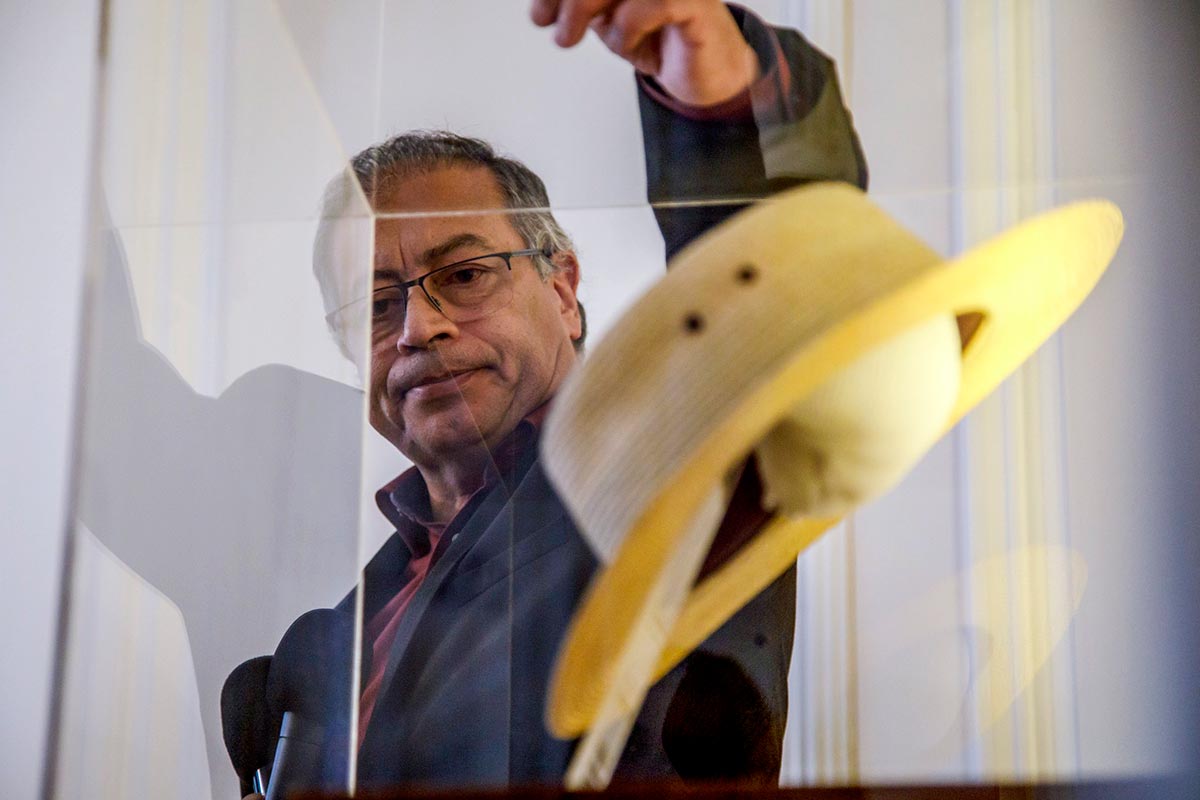
“To publicly romanticize M-19 and its actions is violent”
The loudest voice in repudiating the president’s choice of symbols has been Helena Urán, a political scientist and a victim of the Palace of Justice, who until speaking out was a public servant of his government.
A day after Petro raised the M-19 flag in Zipaquirá, Urán sent him a public message and a private letter. “To publicly romanticize M-19 and its actions is once again violent and empowers those who do not want justice or truth,” she said. Her father, Carlos Horacio Urán, was a State Council senior clerk at the time of the Palace of Justice siege. For two decades his fate was a mystery, until forensic evidence showed that he’d left the building alive, only to be murdered and disappeared by the military. Overwhelmed by threats made to stop looking for him, the Urán family was forced into exile. Helena was 10 years old.
After working in her adoptive Germany’s education program for non-recurrence, Urán returned to Colombia, where she has led initiatives to withdraw military medals of General Jesús Arias Cabrales, convicted over forced disappearances in the Palace of Justice, and requested protective measures for the Juan Frío crematoriums where paramilitaries disappeared hundreds of people. She also wrote a book, in which she doesn’t attribute her father’s death to M-19 but holds it accountable for a takeover that, in her words, was a “necessary condition” for what happened later.
Urán especially questions Petro’s praise of guerrillas. “The symbols he chooses allude to violent moments, of confrontation and little dialogue. They don’t serve the country well because they do not deepen democracy, they only increase confrontation,” she said. “In addition, they’re imposed from a place of power, whereas we know that symbols people feel represented by come from the grassroots.”
As a result of Urán's letter, Culture Minister Juan David Correa - who edited her book - organized a discussion on the power of political symbols, during which Fabio Mariño, another former M-19 member and current member of the government, told Urán that “it is easier to forgive than to ask for forgiveness”.
Petro has not responded to her letter yet. But in mid-June, the Foreign Ministry notified Urán that her contract as the Foreign Ministry’s advisor on non-recurrence, would not be renewed.
Memories for peace and memories for war
For María Emma Wills, a political scientist who worked for a decade as a researcher at the state-run National Center of Historical Memory, “it’s not the symbol itself, but the path Petro chooses to introduce it into the national narrative, without discussing it with other people and especially others who might think differently”, she said. “It’s what makes it hard not to think of it as official history.” In her most recent book Memories for peace or memories for war, she argues that there are public narratives that stoke hatred and create conditions for new cycles of violence, while others promote democratic dialogue and make better citizens.
In her view, the former -which she calls “total memories”- tend to be binary and star heroes and villains, while glorifying sweeping narratives about armed conflict and reinforcing fractures in society that may become insurmountable. Whereas what she calls “the diversity of memories” dignify the voices of victims, foster that those who saw themselves as enemies now do so as legitimate opponents, and promote living in plurality, not against each other. “Petro is clearly trying to broaden the narrative, emphasising a new official memory to counter another one. One wonders, what is the transformation then, if it’s going to be appropriated by his followers but not by other segments of society?” asks Wills.
Perhaps the symbol most in keeping with that second dimension is the vertical canoe made by artist Mario Opazo from the molten copper of bullets decommissioned by the former FARC and installed in 2017 in the United Nations' garden in New York. Ignored by the previous government of Iván Duque, the monument was officially inaugurated by Petro last week. In the president’s words, it represents “the desire to move forward as a society that has much to be sad about, but much more to dance, rejoice and live for.”
